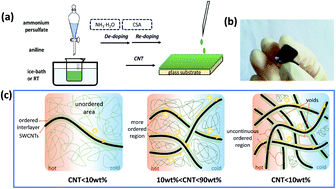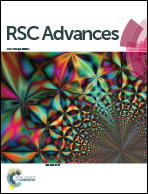Flexible PANI/SWCNT thermoelectric films with ultrahigh electrical conductivity†
Abstract
The effects of polyaniline (PANI) with different polymerization times on the film-forming and thermoelectric properties as well as on the performance of SWCNTs/PANI composites were systematically investigated in this study. It was found that the film-forming and flexibility of PANI films improved with the increase in polymerization time. We showed that a super high conductivity of ∼4000 S cm−1 can be achieved for the SWCNTs/PANI composite film, which is the highest value for the SWCNTs/PANI system at present. Both the electrical conductivity and power factor increase by an order of magnitude than that of pure PANI films and far exceed the theoretical value of the mixture model. These results suggest that the sufficiently continuous and ordered regions on the interlayer between the filler and matrix are key to improve the electrical conductivity of composites. Finally, the maximum PF reaches 100 μW m−1 K−2 at 410 K for the 0.6CNT/PANI5h. Furthermore, it is found that the composite films have excellent environmental and structural stability. Our results can deepen the understanding of organic–inorganic thermoelectric composite systems and facilitate the practical application of flexible and wearable thermoelectric materials.



 Please wait while we load your content...
Please wait while we load your content...